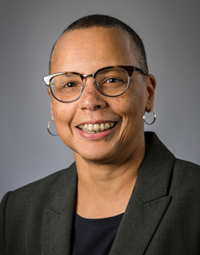Tonya Jackson: Signed, Sealed, Delivered
Tonya Jackson is senior vice president and chief supply chain officer with Lexmark, a creator of imaging solutions and technologies.
Responsibilities: Worldwide supply chain operations, including supply planning, global sourcing, hardware and supplies manufacturing, distribution and logistics, and managing shared service centers.
Experience: Vice president, global supply chain operations; vice president, supplies operation and engineering; all with Lexmark.
Education: MBA, Ohio University; M.S., Chemistry, Vassar College; B.S., Chemistry, Hampton University.
The pandemic has presented one challenge after another, but it has also offered some fantastic learning opportunities. For instance, as the virus made its way around the world, we had to shut down or greatly reduce operations in one area and shift to another.
First Mexico told China, "Don’t worry. We will back you up." Then when Mexico went down, China covered for some of Mexico’s production. In April 2020, an industry report said Lexmark had the highest in-stock availability for printers. It was because we leveraged our global operations to cover production.
Geopolitical concerns are becoming an area of emphasis. More governments expect companies that distribute products in their countries to also manufacture there. Lexmark’s regional manufacturing model for cartridges allows us to be closer to the customer and more responsive. It has also served us well during the pandemic.
Lexmark’s printer side is more centralized because the volume is lower, and it’s not cost-effective to maintain multiple manufacturing sites. By keeping both a consolidated base and regional sites, we can be flexible with product delivery. We’re also better able to see trends around the world.
The biggest opportunity in supply chain is in product design. If products are designed to be easily manufactured and as common and flexible as possible, we have the best chance to control other metrics, such as availability, inventory, and delivery. So, Lexmark’s end-to-end supply chain encompasses everything from partnering with research and development (R&D) to manufacturing to warehousing and distribution.
A collaboration between sales, product development, and supply chain has simplified and rationalized our models. We’ve reduced the number of factory models feeding our North America regional manufacturing operation by 45%. That allows us to reduce inventory by 15% to 20% and to be more flexible in our regional operations.
We’re also studying our logistics and distribution networks to both streamline operations and better serve our customers. In addition, to get data to all departments at the same time, we’re making greater use of business analytics. Leveraging data analytics will be invaluable in helping us know where products are, where they should be, and how to move them.
Earlier in my career, I was with IBM in a process development role in R&D. IBM sold the printer division, which became Lexmark. At that time, I was in the group of 15 people who were asked to design Lexmark’s first ink jet printhead cartridge.
This small team was composed of both R&D and supply chain team members. When I left R&D for supply chain, I was able to see the supply chain that I had built as an R&D person. It was about the ugliest thing you could have imagined, because I didn’t make design decisions with an appreciation of sustaining this difficult supply chain over many years.
For example, I had chosen niche suppliers based on technology needs. This resulted in multiple single-skilled suppliers in various locations. There was no opportunity for supplier consolidation, dual sourcing, or risk mitigation.
But this experience helped me in my later conversations with R&D. I tell them, "We have to live with the things we’re doing forever." My supply chain team integrates with R&D. We make informed trade-offs and everybody pulls together.
Tonya Jackson Answers the Big Questions
1. What song title best describes your role?
One is "Signed, Sealed, Delivered" by Stevie Wonder. During the pandemic, I played "Don’t Stop ‘Til You Get Enough" by Michael Jackson nonstop.
2. Any words to live by?
One of my managers once told me, "As a manager, you will get far more blame than you deserve for your team, and way more credit than you ever deserve for leading a team. Learn how to accept both."
3. What advice would you give youe 18-year-old self?
You do not have to be perfect. You just have to believe in yourself and whatever goals or plans you have. Don’t try to do everything 100% because then it never gets done. But be honest with yourself. Know your risks and how you need to respond.
4. How would you describe your younger self?
One-hundred percent nerd. I’m a card-carrying nerd and proud of it. No wild parties in my youth.

